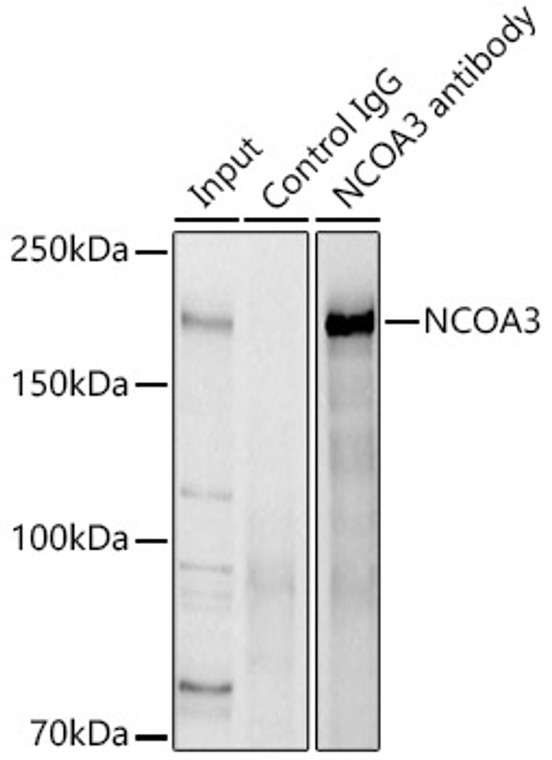| Host: |
Rabbit |
| Applications: |
WB/IP |
| Reactivity: |
Human |
| Note: |
STRICTLY FOR FURTHER SCIENTIFIC RESEARCH USE ONLY (RUO). MUST NOT TO BE USED IN DIAGNOSTIC OR THERAPEUTIC APPLICATIONS. |
| Short Description: |
Rabbit polyclonal antibody anti-NCOA3 (1-100) is suitable for use in Western Blot and Immunoprecipitation research applications. |
| Clonality: |
Polyclonal |
| Conjugation: |
Unconjugated |
| Isotype: |
IgG |
| Formulation: |
PBS with 0.01% Thimerosal, 50% Glycerol, pH7.3. |
| Purification: |
Affinity purification |
| Dilution Range: |
WB 1:500-1:1000IP 1:50-1:200 |
| Storage Instruction: |
Store at-20°C for up to 1 year from the date of receipt, and avoid repeat freeze-thaw cycles. |
| Gene Symbol: |
NCOA3 |
| Gene ID: |
8202 |
| Uniprot ID: |
NCOA3_HUMAN |
| Immunogen Region: |
1-100 |
| Immunogen: |
A synthetic peptide corresponding to a sequence within amino acids 1-100 of human NCOA3 (NP_858045.1). |
| Immunogen Sequence: |
MSGLGENLDPLASDSRKRKL PCDTPGQGLTCSGEKRRREQ ESKYIEELAELISANLSDID NFNVKPDKCAILKETVRQIR QIKEQGKTISNDDDVQKADV |
| Tissue Specificity | Widely expressed. High expression in heart, skeletal muscle, pancreas and placenta. Low expression in brain, and very low in lung, liver and kidney. |
| Post Translational Modifications | Acetylated by CREBBP. Acetylation occurs in the RID domain, and disrupts the interaction with nuclear receptors and regulates its function. Methylated by CARM1. Phosphorylated by IKK complex. Regulated its function. Phosphorylation at Ser-601 by CK1 promotes coactivator function. |
| Function | Nuclear receptor coactivator that directly binds nuclear receptors and stimulates the transcriptional activities in a hormone-dependent fashion. Plays a central role in creating a multisubunit coactivator complex, which probably acts via remodeling of chromatin. Involved in the coactivation of different nuclear receptors, such as for steroids (GR and ER), retinoids (RARs and RXRs), thyroid hormone (TRs), vitamin D3 (VDR) and prostanoids (PPARs). Displays histone acetyltransferase activity. Also involved in the coactivation of the NF-kappa-B pathway via its interaction with the NFKB1 subunit. |
| Protein Name | Nuclear Receptor Coactivator 3Ncoa-3ActrAmplified In Breast Cancer 1 ProteinAib-1Cbp-Interacting ProteinPcipClass E Basic Helix-Loop-Helix Protein 42Bhlhe42Receptor-Associated Coactivator 3Rac-3Steroid Receptor Coactivator Protein 3Src-3Thyroid Hormone Receptor Activator Molecule 1Tram-1 |
| Database Links | Reactome: R-HSA-1989781Reactome: R-HSA-381340Reactome: R-HSA-5617472Reactome: R-HSA-5687128Reactome: R-HSA-9018519 |
| Cellular Localisation | CytoplasmNucleusMainly Cytoplasmic And Weakly NuclearUpon Tnf Activation And Subsequent PhosphorylationIt Translocates From The Cytoplasm To The Nucleus |
| Alternative Antibody Names | Anti-Nuclear Receptor Coactivator 3 antibodyAnti-Ncoa-3 antibodyAnti-Actr antibodyAnti-Amplified In Breast Cancer 1 Protein antibodyAnti-Aib-1 antibodyAnti-Cbp-Interacting Protein antibodyAnti-Pcip antibodyAnti-Class E Basic Helix-Loop-Helix Protein 42 antibodyAnti-Bhlhe42 antibodyAnti-Receptor-Associated Coactivator 3 antibodyAnti-Rac-3 antibodyAnti-Steroid Receptor Coactivator Protein 3 antibodyAnti-Src-3 antibodyAnti-Thyroid Hormone Receptor Activator Molecule 1 antibodyAnti-Tram-1 antibodyAnti-NCOA3 antibodyAnti-AIB1 antibodyAnti-BHLHE42 antibodyAnti-RAC3 antibodyAnti-TRAM1 antibody |
Information sourced from Uniprot.org
12 months for antibodies. 6 months for ELISA Kits. Please see website T&Cs for further guidance






